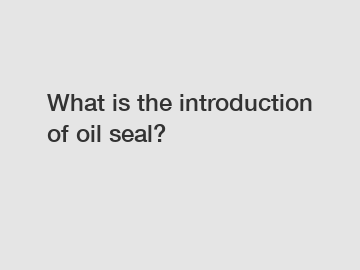What is the introduction of oil seal?
In today's world, where we rely heavily on machinery and engines, it is essential to understand the various components that make them function seamlessly. One such critical component is the oil seal. Often overlooked, yet indispensable, oil seals play a vital role in preventing lubricant leakage and external contaminants from entering the machinery's internal systems. In this blog, we will delve into the world of oil seals, exploring their purpose, types, and significance in ensuring smooth operations of industrial equipment.
The Purpose of Oil Seals:
Oil seals, also known as rotary shaft seals, are designed to provide a barrier between the internal and external parts of a rotating device, such as an engine or pump. Their primary function is to prevent the escape of lubricating oils, greases, or hydraulic fluids, while simultaneously keeping out dirt, dust, and water. By doing so, oil seals protect the components from premature wear, reduce downtime caused by mechanical failures, and extend the overall lifespan of the equipment.

Types of Oil Seals:
Oil seals are available in various designs and materials, each tailored to specific applications. Some commonly used types include:
1. Radial Lip Seal: This type of oil seal consists of a metal housing and a flexible lip made of rubber or elastomer. The lip seals against the rotating shaft, creating a tight barrier that prevents fluid leakage. Radial lip seals work efficiently in both low and high-speed applications, offering excellent resistance to temperature, pressure, and chemical exposure.
2. V-Ring Seal: V-ring seals are versatile and suitable for numerous applications. Shaped like a "V," these seals utilize an elastic body made of rubber or thermoplastic material. They are particularly effective in sealing axially moving shafts, providing reliable protection against both dust and fluid contamination.
3. Cassette Seal: Cassette seals are commonly found in heavy-duty machinery and vehicles, often used as wheel seals. They consist of a two-part design, comprising a stationary metal housing and a replaceable sealing element. These robust seals excel in applications with high pressures and contaminants, offering exceptional sealing properties and long service life.
4. Mechanical Seal: Unlike the previously mentioned seals, mechanical seals are used in applications that require a hermetic seal, such as pumps and compressors. Composed of two flat faces pressed together with a spring-loaded mechanism, mechanical seals prevent leakage by using a combination of friction and fluid pressure. These seals are highly efficient but require regular maintenance to ensure optimal performance.
The Significance of Oil Seals:
Oil seals are found in countless industrial settings, ranging from automotive and aerospace to heavy machinery and manufacturing plants. Their significance extends beyond preventing fluid leakage; they contribute to:
1. Efficient Operations: By effectively sealing rotating equipment, oil seals maintain the lubrication system's integrity, allowing for smoother and more efficient machinery operations. This, in turn, minimizes energy consumption and reduces the risk of premature component wear.
2. Environmental Protection: Oil seals help prevent hazardous fluids from escaping into the environment, reducing the impact on ecological systems. Furthermore, by keeping out contaminants, they play a crucial role in maintaining the purity and quality of lubricants, preventing pollution and costly damage to equipment.
3. Cost Savings: Investing in high-quality oil seals ensures extended equipment life, reducing the need for frequent repairs and replacements. By providing a reliable barrier against leakage and contamination, oil seals contribute significantly to cost savings in the long run.
Conclusion:
Oil seals may seem like inconspicuous components, but their role in ensuring the smooth functioning and longevity of machinery cannot be underestimated. By preventing fluid leakage and external contamination, oil seals safeguard valuable assets, increase efficiency, and reduce unnecessary downtime. Understanding the various types of oil seals and choosing the appropriate ones for specific applications is crucial for maintaining optimal performance. So whether it's an automobile engine, a complex hydraulic system, or an industrial gearbox, the humble oil seal silently protects and preserves, allowing us to harness the power of technology.
Want more information on Standard Seals, tc rubber seal, Silicone Rubber Cord? Feel free to contact us.

Comments
0